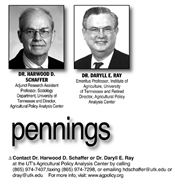|
Are The “High” Crop-Price Years We Experienced In The Last Decade The New Norm?

The number one issue facing row crop farmers for the past 4 or 5 years has been price and, with it, net farm income. Since the 2005 crop marketing year, both corn and soybeans have experienced demand shocks that have had a significant impact of the price farmers have received.
In the late first decade of this century the demand for corn to be converted into ethanol increased rapidly. In 2005, the US converted 3.0 billion bushels of corn into food, seed and industrial (FSI) uses – mostly ethanol. By 2010, that number was 6.4 billion bushels an increase of 682 million bushels a year.
As a result of that rapid increase in demand, the price of corn increased as well. The price of corn went from $2.00 per bushel in 2005 to $5.18 in the 2010 crop marketing year. The drought of 2012 took the season average price of a bushel of corn to $6.89, with local prices above $7.00 in parts of the country.
But with the increase in FSI corn demand tapering off after 2010 to just 43 million bushels a year, the price declined to $3.36 in 2017 and 2018. Marginally lower production levels in 2018 and 2019 resulted in slightly higher corn prices of $3.61 and $3.89 respectively.
In 2005, US soybean exports were 940 million bushels. With China importing more soybeans, by 2010 US soybean exports had increased to 1.5 billion bushels, an increase of 113 million bushels a year. As a result, soybean prices increased from $5.66 in the 2005 crop marketing year to $11.30 per bushel in 2010. The 2012 drought in the Midwest drove the season average soybean price to $14.40 per bushel.
Between 2010 and 2017 soybean exports has slowed to an average increase of 90 million bushels a year, peaking at 2.17 billion bushels a year in 2016. Between 2014 and 2017 the soybean price averaged $9.51.
The trade dispute between the US and China resulted in 2018 soybean exports declining by 386 million bushels as the price fell to $8.48 per bushel. The projected 2019 soybean price is $8.75 as the result of a 20 percent drop in production caused by flooding earlier in the year.
With this history in mind, what might we be looking at for the 2020 crop year? As always, it all depends upon a number of things. For both soybeans and corn, if we get even average weather for both crops, we could see prices decline below the lows seen since the 2012 peak.
At this point the fly in the soup bowl is COVID-19. We are already seeing serious disruptions for other products in international markets and it seems a certainty that agricultural markets will not be spared a period of disruption that will put additional downward pressure on prices for corn and soybeans as well as most other crops.
In the past week we have heard Secretary of Agriculture, Sonny Purdue declare that there will be no more Market Facilitation Program payments (MFP) after the current tranche of payments ends. That does not bode well for net farm income in 2020.
From the beginning we have argued that the MFP payments are Emergency Payments in disguise. With the end of the MFP, it will be up to Congress (not the President who used CCC borrowing authority to fund the MFP) to either reopen the 2018 Farm Bill – unlikely – or enact up to $20 billion in Emergency Payments.
It is important to keep in mind that the high prices experienced during the last decade occurred for very specific short-term reasons. Because of that, it is illogical to expect “high” prices to be the new norm with “low” prices being random variations thereof – unless of course the future is dominated by US yield-shortfalls and/or export spikes, which could happen but historically would be a precarious expectation.
If 2020 is a relatively “normal” crop year, prices will fall sharply, and a Farm Crisis will ensue. And, if conditions continue beyond the 2020 crop year, the crisis could be of a severity not seen since the 1980s. ∆
DR. HARWOOD D. SCHAFFER: Adjunct Research Assistant Professor, Sociology Department, University of Tennessee and Director, Agricultural Policy Analysis Center
DR. DARYLL E. RAY: Emeritus Professor, Institute of Agriculture, University of Tennessee and Retired Director, Agricultural Policy Analysis Center
|
|